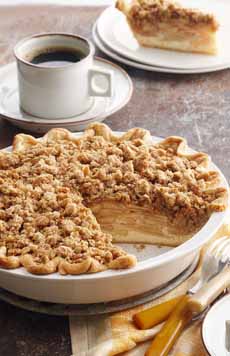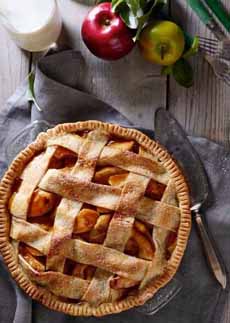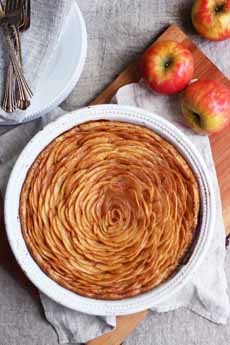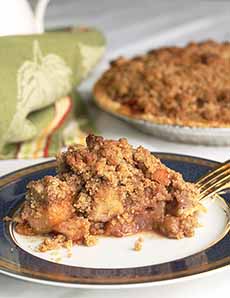FOOD 101: Apple Pie History & The Different Types Of Apple Pie
 [1] The classic: as American as apple pie (photo © Mackenzie Ltd).
|
December 3rd is National Apple Pie Day. It’s time to get your fork and dig in! The history of apple pie follows. Elsewhere on The Nibble, you’ll find: > The different types of pie: a photo glossary. > The year’s 19 apple holidays. > The year’s 15+ pastry holidays. > The differences between pies and tarts. While apples were baked in pastry long before they were mentioned in print, the first written apple pie recipe dates to 1381 England. The recipe, printed by Geoffrey Chaucer, included apples, figs, raisins and pears—but no sugar—baked in a pastry shell. Western Europeans only discovered sugar as a result of the Crusades, in the 11th Century C.E. The first mention of sugar in England was in 1099. By 1319 C.E. it was published that sugar was available in London at two shillings per pound, today’s equivalent of $100 per kilo [source]. Why didn’t Chaucer add honey? It’s too late to ask now. Maybe the fruit was so sweet then, before modern hybridization for commercial benefits, that the natural sweetness levels were fine. He could have used honey: Honey bees, though not native to Britannia, were introduced by the Romans around 500 C.E. (the history of honey). Apple pie is one of America’s cultural food icons, but it isn’t native. It was brought to the U.S. by Dutch and English settlers. Apples themselves are native to Central Asia; the only apples native to North America are crab apples. Apple varieties for both cider and pies made their way to Europe, where large numbers of orchards were planted. As ships were provisioned for their voyages to the New World in the 17th century, young trees or cuttings were brought to America. The first apple orchard in North America was planted in Boston by Reverend William Blaxton, in 1625. Today, the apples in apple pie are typically mixed with cinnamon, nutmeg, lemon juice and a pinch of salt. Other ingredients may be added, such as: Shortcrust is typically made without sugar, although sugar and eggs can be added. So can cCheddar cheese. Here’s how to make a cheddar cheese crust, honoring a New England tradition of pairing a slice of apple pie with a wedge of cheddar. There are numerous types of apple pies—not to mention tarts and pastries—from which to choose. The journey can take you galettes to phyllo crusts to fried pocket pies, mini pies-on-a-stick and beyond. We’ve even had cheesecake apple pie and apple pie with a cinnamon-tortilla chip crust. Here are a few of types you may encounter in the U.S.: We’ve all heard the phrase, “as American as apple pie.” While apple pie is America’s most popular (followed by pumpkin and pecan), the pie came to us via English and Dutch immigrants. Did you ever wonder about the phrase “apple pie order,” meaning perfectly organized? What does apple pie have to do with organization? Perhaps it’s due to the neat layering of sliced apples in an apple pie? Actually, it’s likely an English mistranslation from the French nappe pliée ordre, meaning neatly folded linen napkins. It’s an oldie: The phrase was first recorded in 1780 in Pasley’s Private Sea Journals: “Their Persons Clean and in apple-pie order on Sundays.” |
|
|
CHECK OUT WHAT’S HAPPENING ON OUR HOME PAGE, THENIBBLE.COM. |
||







